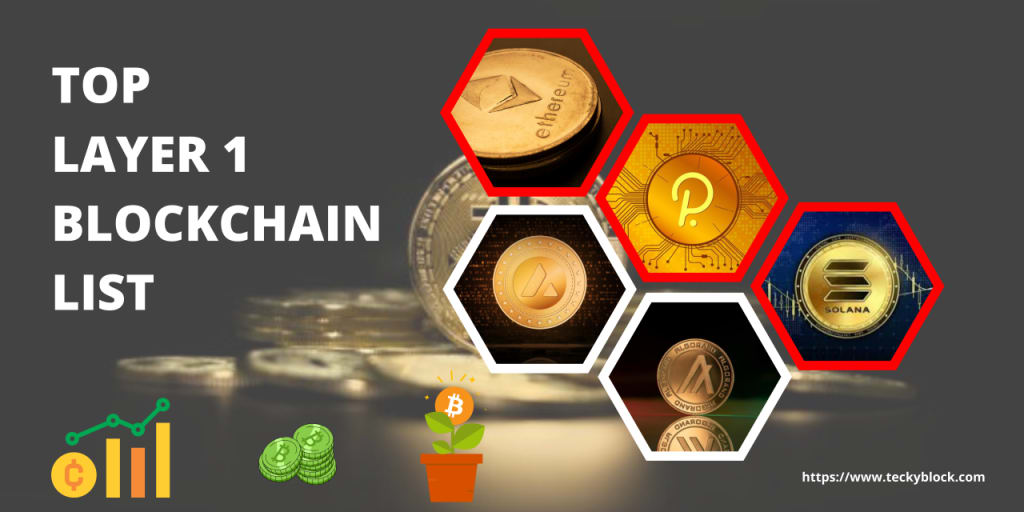Top Layer 1 Blockchain List: The Most Promising Projects of 2023
Are you curious about the best layer 1 blockchain to watch out for in the upcoming year? In this article, we'll be exploring the top layer 1 blockchain list, which includes some of the most promising blockchain projects to look out for. From scalability solutions to unique consensus algorithms, we'll be diving deep into what makes these projects stand out and why they're worth keeping an eye on. Whether you're a crypto enthusiast, investor, or blockchain developer, this article is for you!

Introduction
Blockchains have become a popular technology in recent years, and for a good reason. They offer decentralized, transparent, and secure transactions that are immutable and cannot be altered. But not all blockchains are created equal. Layer 1 blockchains are at the forefront of this technology, offering a solid foundation for decentralized applications (dApps) and protocols.
Layer 1 blockchains are the first layer of a blockchain system and form the backbone of the network. They are responsible for executing smart contracts and transactions, ensuring consensus, and securing the network. These blockchains are designed to be scalable, fast, and secure, making them ideal for building large-scale decentralized applications.
In this article, we will explore the top layer 1 blockchain list for 2023. We will examine the criteria for selection, provide a brief overview of each project, analyze their strengths and weaknesses, and discuss their potential impact on the blockchain industry.
Also Read: A Beginner's Guide to Blockchain Technology: How to become blockchain expert from Blockchain Council
Criteria for Selection
Selecting the top layer 1 blockchain projects requires a thorough evaluation of various factors. The criteria used to select these projects include:
- Scalability: The blockchain must be able to handle a large number of transactions per second (TPS) to accommodate mass adoption.
- Security: The blockchain must have strong security measures in place to prevent hacks and attacks.
- Decentralization: The blockchain must be truly decentralized, with no single point of failure or control.
- Unique Features: The blockchain must have unique features or innovations that differentiate it from another layer 1 blockchain.
With these criteria in mind, let's dive into the top layer 1 blockchain list for 2023.
Also Read: Crypto for Free: 5 Simple Ways to Earn Cryptocurrency Without Spending a Penny
Top Layer 1 Blockchain List
Ethereum
Ethereum is one of the most well-known and widely used layer 1 blockchain, with a market capitalization of over $400 billion. It was designed to be a platform for decentralized applications and has been a popular choice for developers building dApps. Ethereum 2.0, the latest version of the blockchain, promises to address scalability issues by implementing a new consensus algorithm known as Proof-of-Stake.
Polkadot
Polkadot is a layer 1 blockchain that allows for interoperability between different blockchain networks. It aims to create a decentralized and interconnected web, where data and assets can move freely between different blockchains. Polkadot's unique feature is its ability to connect and share data with other blockchains, making it an attractive choice for developers building multi-chain applications.
Solana
Solana is a layer 1 blockchain that boasts high-speed transactions and low fees, making it an attractive option for developers building decentralized finance (DeFi) applications. Solana's unique feature is its consensus algorithm, which allows for fast confirmation times and high throughput.
Avalanche
Avalanche is a layer 1 blockchain that aims to provide fast and secure transactions, with high throughput and low fees. Its unique feature is its consensus algorithm, which allows for multiple subnets to run in parallel, making it highly scalable.
Algorand
Algorand is a layer 1 blockchain that focuses on security and scalability. Its unique feature is its consensus algorithm, which ensures fast and secure transactions. Algorand's smart contracts are also designed to be energy-efficient, making it an environmentally friendly choice.
Detailed Analysis of Top Layer 1 Blockchain Projects
Ethereum
Ethereum has been around since 2015 and has gained a significant following, with over 3,000 decentralized applications built on its platform. However, Ethereum's biggest challenge has been its scalability, with transaction fees and confirmation times increasing as the network becomes more congested. Ethereum 2.0 aims to address these issues by implementing Proof-of-Stake and sharding, which will increase the network capacity and reduce transaction fees.
Another advantage of Ethereum is its strong community and developer support. The Ethereum Foundation provides grants and funding to support the development of the ecosystem, and there are several active communities and forums for developers to collaborate and share ideas.
However, Ethereum's dominance in the dApp market has led to concerns about centralization, as some dApps have become too dependent on the Ethereum network. Additionally, Ethereum's transition to Ethereum 2.0 is still ongoing, with some challenges and delays along the way.
>>Join TradingView today for the ultimate trading experience!<<
Polkadot
Polkadot's focus on interoperability and cross-chain communication makes it a unique player in the blockchain space. Its para-chain architecture allows for multiple blockchains to connect and communicate with each other, making it possible to transfer data and assets between different chains.
Polkadot's ecosystem also includes a wide range of tools and services for developers, including a wallet, explorer, and substrate framework. This makes it easier for developers to build and deploy custom blockchains and applications on the Polkadot network.
However, Polkadot is still a relatively new project, and its para-chain governance model and consensus algorithm are still being tested and refined. Additionally, the Polkadot network is not yet as mature as some other layer 1 blockchain, which may limit its adoption and use cases in the short term.
Also Read: Top Crypto Tax Platforms for Hassle-Free Tax Filing
Solana
Solana's focus on high-speed transactions and low fees makes it an attractive option for developers building DeFi applications. Its unique consensus algorithm, known as Proof-of-History, allows for fast confirmation times and high throughput, making it one of the fastest layer 1 blockchain on the market.
Solana's ecosystem includes several popular DeFi applications, such as Serum and Raydium, and its strong developer community has created several tools and resources for building on the network.
However, Solana's focus on speed and low fees has led to some concerns about decentralization, as the network relies heavily on validators and nodes. Additionally, Solana's governance model and security measures are still being tested and refined, which may limit its adoption in the long term.
Avalanche
Avalanche's unique consensus algorithm, known as Avalanche-X, allows for multiple subnets to run in parallel, making it highly scalable and able to handle high volumes of transactions. Its focus on low fees and fast confirmation times also makes it an attractive option for developers building DeFi applications.
Avalanche's ecosystem includes several popular DeFi protocols, such as Pangolin and Trader Joe, and its interoperability with other blockchains allows for seamless transfers of assets and data.
However, Avalanche's governance model and consensus algorithm are still being tested and refined, and the network is still relatively new compared to some other layer 1 blockchain. Additionally, Avalanche's focus on DeFi applications may limit its adoption in other use cases.
Algorand
Algorand's focus on security and scalability makes it an attractive option for developers building large-scale applications. Its unique consensus algorithm, known as Pure Proof-of-Stake, ensures fast and secure transactions, and its smart contracts are designed to be energy-efficient.
Algorand's ecosystem includes several enterprise clients, such as Circle and VeriTX, and its strong developer community has created several tools and resources for building on the network.
However, Algorand's focus on enterprise clients and large-scale applications may limit its adoption in the DeFi space and other use cases. Additionally, the network's governance model and consensus algorithm are still being tested and refined, which may limit its adoption in the short term.
Also Read: 5 Things to Consider Before Investing in Cryptocurrency
Conclusion
Layer 1 blockchains are at the forefront of blockchain technology, providing a solid foundation for decentralized applications and protocols. The top layer 1 blockchain projects for 2023 include Ethereum, Polkadot, Solana, Avalanche, and Algorand. Each of these projects has unique features and strengths that make them attractive options for developers and users alike.
Ethereum's dominance in the dApp market and strong developer support make it a top choice for building decentralized applications. However, concerns about centralization and the ongoing transition to Ethereum 2.0 may impact its adoption in the short term.
Polkadot's focus on interoperability and its ecosystem of tools and services make it an attractive option for developers looking to build custom blockchains and applications. However, its governance model and consensus algorithm are still being tested and refined.
Solana's focus on high-speed transactions and low fees has made it a popular choice for building DeFi applications. However, concerns about decentralization and ongoing security testing may limit its adoption in the long term.
Avalanche's highly scalable and interoperable network makes it an attractive option for seamless asset transfers and DeFi applications. However, its governance model and focus on DeFi may limit its adoption in other use cases.
Algorand's focus on security and scalability has made it an attractive option for large-scale applications and enterprise clients. However, its focus on enterprise clients and ongoing testing and refinement of its governance model and consensus algorithm may limit its adoption in other use cases.
In conclusion, the top layer 1 blockchain projects for 2023 offer unique features and strengths that cater to a wide range of use cases and development needs. As the blockchain ecosystem continues to evolve and grow, it will be interesting to see how these projects adapt and innovate to stay at the forefront of the industry.
Also Read: Secure Your Crypto Assets with the Best Crypto Hardware Wallets
Originally published at https://www.teckyblock.com on April 4, 2023.
About the Creator
TeckyBlock
Learn about blockchain technology, cryptocurrency, NFT and metaverse in here. please visit https://teckyblock.com for further information.






Comments
There are no comments for this story
Be the first to respond and start the conversation.